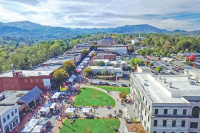Civil War crossing of Smokies was memorable feat
The war in the Smokies proved to be … a curious conjunction of terrain, history, politics, and culture ... a tragic division of loyalties … a brutal partisan conflict
where men left homes and wives and children and trekked north in cold and rain … where still others served in nearly forgotten units to protect border and home.
— Noel C. Fisher, The Civil War in the Smokies
One of the remarkable “nearly forgotten” events that took place in the Smokies region during the Civil War occurred at Indian Gap, situated at 5,317 feet between Clingmans Dome and Newfound Gap along the high divide between North Carolina and Tennessee. On Jan. 12, 1865, a Confederate battery of artillery and about 650 men under the command of General Robert B. Vance crossed the Great Smoky Mountains at Indian Gap in an attempt to secure provisions, screen the main approaches to North Carolina, and guard the left flank of Longstreet’s main Confederate force at Greeneville, Tenn.
The primary military objectives failed for the most part, but the crossing itself — accomplished under the most severe conditions — deserves to be remembered for a number of reasons. Described as one of the more “heroic episodes” to take place during the Civil War in the southern mountains, the crossing has been likened to “Hannibal crossing the Alps in miniature.” It involved the Thomas Legion, one of the most colorful forces in the Confederacy, which consisted of a unit put together by Will Thomas made up of both mountaineers and Cherokees. The Indian component of the Legion was initially comprised of 130 Cherokees. Used primarily as scouts, their role in the war involved alleged “atrocities” of scalping made by the northern press. And the crossing took place over the old Oconaluftee Turnpike, sections of which can still be located.
Related Items
The road was commissioned by the N.C. General Assembly more than three decades prior to the war. Tom Robbins (a now-retired park historian stationed at the Oconaluftee Visitor Center for years) has a long-standing interest in the history of the road. In “Summit Magazine” (Summer 1986), Robbins provided an account of the road’s early history:
“The valley was Cherokee land for hundreds of years before it was given up in a treaty in the 1790’s. By the beginning of the nineteenth century, the first permanent white settlers were occupying land along the banks of the Oconaluftee River. Like many areas throughout the mountains, as the population of the valley grew, so did the need for roads to provide a better means of trade and communication.
“In 1831, the N.C. General Assembly authorized the formation of the Oconaluftee Turnpike Co. to build a road through the valley to the top of the Smoky Mountains. Road commissioners were selected from the local community and authorized to sell stock and collect tolls.
“Construction of the road was difficult and time-consuming. Cliffs and the river had to be avoided, thus lengthening the route. Blasting involved hand-drilling holes in rocks and packing the holes with black powder. Large rocks were sometimes split by burning logs on them, then pouring cold water on the hot rocks.
“The road, completed in 1839, followed an older Indian trail along much of its route. It crossed the Smokies at a point called Indian Gap. Initially, the principal traffic on the turnpike was livestock being driven to market. But not long after the road’s completion several men living in the valley formed the Epson Salts Manufacturing Co. in an attempt to tap the mineral resources [at Alum Cave] on the southwestern side of Mount LeConte in Tennessee.”
Robins believes the turnpike gate was probably situated beside the Oconaluftee River about where the present boundary is situated between the national park and Cherokee lands. He has walked the old road up the north bank of the river from the visitor center to the Smokemont Campground area and on to the Kephart Prong trailhead, where it “sort of gets lost” in the old roadways cut there during the CCC days of the 1930s.
Two of the most visible and accessible sections of the Oconaluftee Turnpike are to be found alongside U.S. 441: (1) at the Kephart Prong trailhead cross the footbridge, proceed 100 yards along the main trail, then follow a side trail (to the right) where the old trace is obvious as it is worn up to five feet deep; and (2) at the Oconaluftee Overlook (just below Newfound Gap), where a clearly defined section winds up from the overlook area toward the Clingmans Dome road along the main ridge.
Accounts differ as to just when Thomas started improving the road. The version published in 1914 by John Preston Arthur in Western North Carolina: A History from 1730-1913 is perhaps the most accurate. Arthur states that Thomas obtained “an order from General Kirby Smith in the spring of 1862 to raise a battalion of sappers and miners ... and put them to making roads, notably a road from Sevier County, Tennessee, to Jackson County, N.C. This road followed the old Indian trail over the Collins Gap [another name for Indian Gap], down the Ocona Lufty river to near what is now Whittier, N.C. [ten miles east of Bryson City].”
In January 1864, the 58-year-old Will Thomas and 125 of the Cherokees joined about 100 infantry, 375 cavalry, and one section of artillery Vance had marched from Asheville to acquire provisions and take up positions in Tennessee. By all accounts the winter of 1864 was unusually cold with considerable snow in the higher elevations. According to William R. Trotter’s Bushwackers! The Civil War in North Carolina (vol. 2, 1988):
“The Indian Gap road that … had been hacked through the mountains toward Sevierville was passable as far as the crest of the Smokies, but beyond that the route was little more than a mule-path: steep, rocky, and too narrow even for an ox cart. But what oxen could not do, men could. At the crest, Vance’s men dismantled their artillery. Teams of men carried the wheels, axles, rigging, and ammunition. The gun barrels themselves were harnessed to ropes and rolled, pushed, or dragged down the far side, gun metal screeching on naked rock. The march was characterized not only by Homeric physical exertion, but also by vile weather; Vance and his men did all this into the teeth of savagely cold winds that scoured the mountain tops like a sand-blaster ....”
After reassembling their equipment at the base of the Smokies, Vance’s men had initial success on Jan. 13 with the capture of a Union caravan of about 30 wagons. But shortly thereafter, flushed and cocky by his “little victory,” Vance was smashed at Schultz’s Mill on Cosby Creek by Col. William Palmer’s 15th Pennsylvania Calvary.”
George Ellison wrote the biographical introductions for the reissues of two Appalachian classics: Horace Kephart’s Our Southern Highlanders and James Mooney’s History, Myths, and Sacred Formulas of the Cherokees. In June 2005, a selection of his Back Then columns was published by The History Press in Charleston as Mountain Passages: Natural and Cultural History of Western North Carolina and the Great Smoky Mountains. Readers can contact him at P.O. Box 1262, Bryson City, N.C., 28713, or at This email address is being protected from spambots. You need JavaScript enabled to view it..









